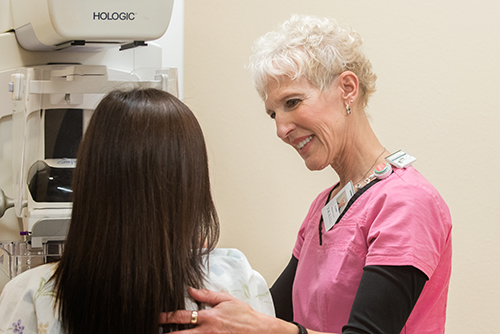Top Ten Myths Around Breast Cancer and Mammograms

October has come and gone with its multitude of pink reminders about Breast Cancer Awareness. Every year, fundraisers, walks, and messages abound to spread the word about the importance of early screening but still, misconceptions exist, particularly when it comes to mammograms. Members of TRA Medical Imaging’s Olympia team shared some of the issues they routinely encounter.
MYTH #1: Women with no family history of breast cancer have no risk of getting the disease.
Women who have a family history of breast cancer may have an increased risk of getting the disease. However, statistically, only about 10-20 percent of individuals diagnosed with breast cancer have a family history of this disease.
Myth #2: It’s okay to skip a year between mammograms.
At TRA, the standard is one year between exams. Mortality in diagnosed cancer patients may increase by 20 percent when screening occurs every other year instead of every year. “Sometimes I hear patients talking about not wanting to get radiated every year,” says Jeffrey Perez, Site Manager at TRA’s Olympia office. “The equipment we have now is way ahead of the game. They’ve reduced the radiation dose significantly.”
Various recommendations have been presented by both the United States Preventative Task Force stating that women should begin having mammograms age 50 and every other year thereafter; the American Cancer Society states that women should start age 45. The radiologists at TRA Medical Imaging stand by the recommendations of the American College of Radiology (ACR.org), the Society of Breast Imaging, and others such as BreastCancer.org that recommend those 40-years-old or older get checked yearly.
MYTH #3: A breast injury can develop into breast cancer.
There is no evidence that bruising or injuring your breast(s) leads to cancer. “One reason for this myth is that an injury may draw attention to the area, thus making it easier to notice a lump or tumor that’s actually been present for some time,” says radiologist Dr. Grant Tibbetts. Regardless, if you notice something unusual, get it checked out.
MYTH #4: If I have a breast lump, it must be cancer.
While a lump in your breast should never be ignored, only a small percentage of breast lumps turn out to be cancer. Roughly 80 percent of lumps in women’s breasts are caused by benign changes, cysts, or other conditions. “It’s always important to have your physician check it out; breast cancer that is diagnosed at an early stage is more likely to be treated successfully,” says Tibbetts.
MYTH #5: Lumps are the only sign of breast cancer.
Lumps are not the only sign of breast cancer. Women may experience other signs or symptoms such as skin irritation, unusual pain or rashes. A bloody discharge or nipple change are additional important warning signs. It is imperative not to ignore these changes. Most importantly, pay attention to your body. Discuss with your provider any concerns you might have about changes in your breast health.
MYTH #6: Men can’t get breast cancer.
In fact, 1 in 1,000 men will be diagnosed with Breast Cancer. “We have men come through here every month for ultrasound, mammograms and biopsies,” says Perez. “Often they’re embarrassed or not sure why they’re here, but with men the treatment tends to be more invasive so it’s really important that they stay on top of the issue.”
MYTH #7: Radiation from breast imaging is dangerous.
Mammograms expose the breasts to small amounts of radiation, but the benefits of mammography outweigh any possible harm from the radiation exposure. To put radiation dose into perspective, people in the United States are normally exposed to an average of 3-6 milliSieverts (mSv) of radiation each year just from their natural surroundings. This is called background radiation. The dose of radiation used for a screening mammogram of both breasts is 0.5-1.0 mSv, or about the same as a round trip flight to Paris and back. For a woman in Thurston County, it’s comparable to visiting your friend in Denver for a couple weeks.
MYTH #8: Silicone breast implants increase the chance of breast cancer.
Studies have found that silicone breast implants do not increase the risk of developing breast cancer.
MYTH #9: Young women don’t need to worry about breast cancer.
Breast cancer can affect women of any age. The disease is more common in post-menopausal women, but 25 percent of women with breast cancer are younger than 50. Younger women should have a yearly breast exam by their health care provider and begin mammography screenings at age 40*. If you have unusual breast changes, please let your healthcare provider know.
MYTH #10: If I have a normal screening mammogram result, I don’t need a mammogram next year.
Evidence has shown that women who skip a yearly mammogram may miss the opportunity for an early breast cancer diagnosis. Women whose breast cancer is detected at an early stage have a 93 percent or higher survival rate in the first five years.
*The radiologists at TRA Medical Imaging stand by the recommendations of both the American College of Radiology, the Society of Breast Imaging, and others such as BreastCancer.org that women should have their mammogram beginning at the age of 40 and every year after.
http://www.thurstontalk.com/2018/11/27/top-10-myths-around-breast-cancer-and-mammograms/
